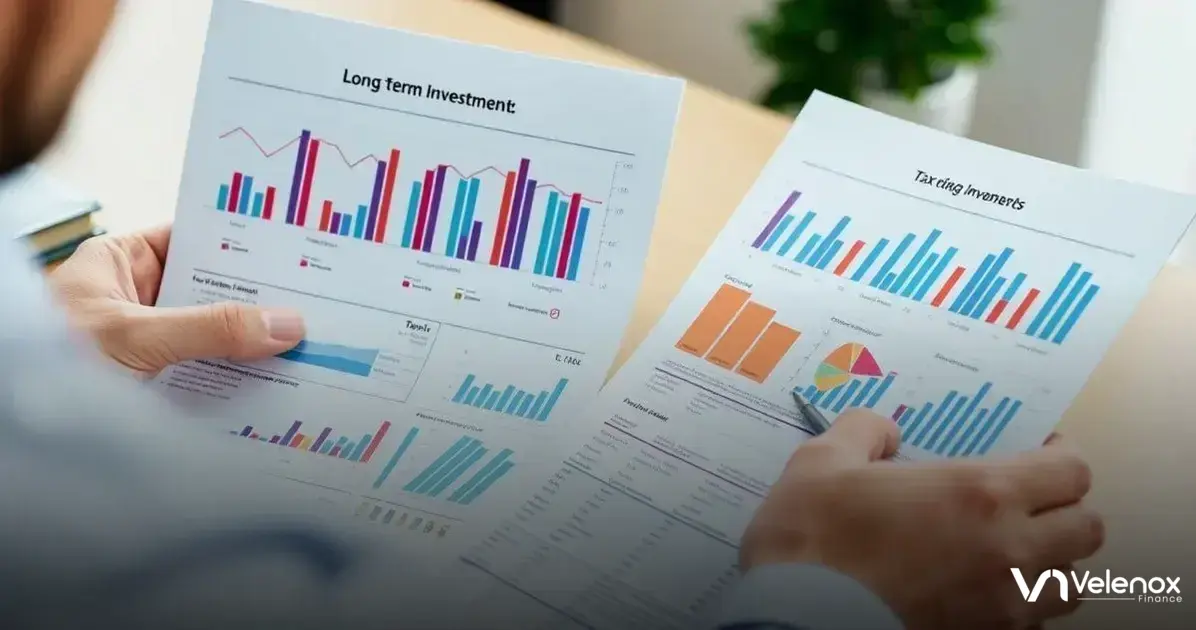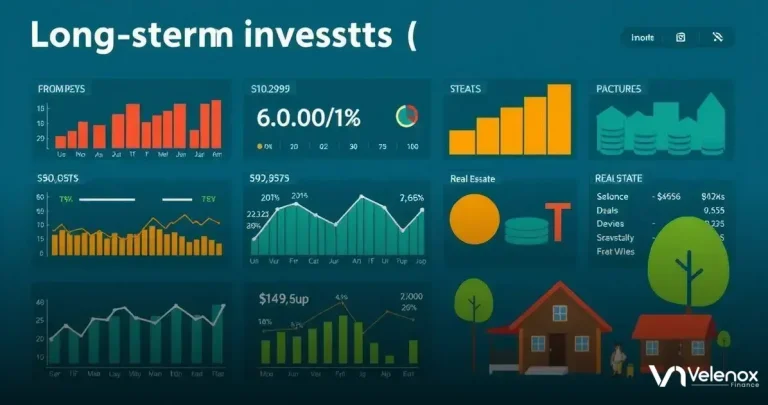Top long-term investments can secure your financial future and provide peace of mind.
In today’s ever-changing market, understanding how to choose these investments is crucial for wealth growth.
What Are Long-Term Investments?
Long-term investments are assets you buy and hold for several years, or even decades.
They have the potential to grow in value over time, helping you build wealth.
ADVERTISEMENT
These investments typically include stocks, bonds, real estate, and mutual funds. The idea is to let your money work for you while you wait for significant returns.
With long-term investments, the focus is not on quick profits but on steady growth.
By holding onto your investments, you can ride out market fluctuations and avoid the emotional stress of day-to-day changes.
This strategy often leads to better financial results, as history shows that markets tend to rise over time.
Investing for the long haul can also provide benefits such as dividends and interest income.
These returns can be reinvested to grow your portfolio even more.
Overall, understanding what long-term investments are can set you on the path to a secure financial future.
Benefits of Long-Term Investing
Long-term investing offers many benefits that can help you secure your financial future.
One of the main advantages is the potential for significant growth over time.
When you invest for the long haul, your money has the chance to increase in value, allowing you to build wealth.
This is especially true when you consider the power of compound interest, where you earn interest not only on your initial investment but also on any interest you accumulate.
Another benefit of long-term investing is that it reduces stress and worry.
Since you are not focused on short-term market fluctuations, you can avoid the emotional ups and downs that often come with daily trading.
This steady approach helps you stay committed to your investment plan and can lead to more rewarding financial outcomes.
Finally, long-term investing often provides additional income through dividends and interest payments.
These earnings can be reinvested, giving your investments a boost.
By taking advantage of the many benefits of long-term investing, you set yourself up for a more secure financial future.
Different Types of Long-Term Investments
There are several types of long-term investments that can help you achieve financial stability. One common option is stocks.
Investing in stocks means buying shares of a company, which can grow in value over time.
When the company does well, you benefit from its growth, both through increased stock prices and potential dividends.
Another popular choice is real estate. Buying property can be a great long-term investment.
Real estate often appreciates in value, and owning rental properties can also provide a steady stream of income.
This makes real estate a tangible asset that can add to your wealth.
Lastly, you can consider mutual funds or exchange-traded funds (ETFs).
These investments pool money from many investors to buy a wide range of stocks and bonds.
This makes it easier to diversify your portfolio, spreading out the risk while giving you the chance to grow your investments over time.
How to Choose the Right Long-Term Investments

Choosing the right long-term investments starts with understanding your financial goals.
Think about what you want to achieve in the future, whether it’s saving for retirement, buying a home, or funding education.
Knowing your objectives can help you select investments that align with your plans and timelines.
Next, consider your risk tolerance. Not all investments are the same. Some investments, like stocks, can be risky but offer higher potential returns.
Others, such as bonds, tend to be safer but might provide lower returns. It’s important to find a balance between risk and reward that makes you feel comfortable.
Lastly, diversify your investments. Putting your money into a mix of different assets, like stocks, real estate, and mutual funds, can protect you from losses.
This way, if one investment does poorly, others may perform well, helping to secure your financial future.
Diversification is a key strategy when choosing long-term investments.
Factors to Consider in Long-Term Investing
When investing for the long term, one important factor to consider is your investment time horizon.
Knowing how long you plan to hold your investments can help you decide which types to choose.
If you have many years ahead, you might choose riskier assets, as they could have time to recover from any downturns.
Another key factor is market conditions at the time of your investment.
Economic trends, such as inflation rates, interest rates, and market volatility, can affect the performance of your assets.
Staying updated on these conditions can help you make more informed decisions and adjust your strategy accordingly.
Lastly, don’t forget to consider the fees and expenses associated with your investments.
Different funds and investment options have varying costs, which can eat into your returns over time.
Understanding these fees will help you choose options that maximize your profits in the long run, ensuring your investments work harder for you.
Risks Associated with Long-Term Investments
Investing for the long term comes with certain risks that every investor should be aware of. One significant risk is market volatility.
Prices can rise and fall dramatically based on economic changes, political events, or even natural disasters.
This means that even if an investment seems solid, it can still lose value in the short term, causing stress for investors.
Another risk to consider is interest rate changes. When interest rates rise, the cost of borrowing increases, which can lead to lower investment returns.
This is especially true for bonds, as higher rates can make existing bonds less attractive.
Keeping an eye on interest rate trends can help you manage this risk better.
Lastly, inflation is a risk that can erode your purchasing power over time.
Even if your investments grow, if they don’t keep up with inflation, you might find that your money doesn’t go as far in the future.
Understanding how inflation can impact your returns is crucial for long-term planning.
Tips for Successful Long-Term Investing
One of the best tips for successful long-term investing is to start early.
The sooner you begin investing, the more time your money has to grow through compound interest.
Even small amounts can add up over years. So start today, and don’t wait until you have a lot of money. Every dollar counts!
Another important tip is to stay disciplined and avoid emotional decisions. Markets will rise and fall, but it’s important to stick to your long-term plan.
Instead of reacting to daily changes, keep your focus on your overall goals. This strategy can help prevent costly mistakes.
Finally, consider regularly reviewing and rebalancing your portfolio.
As time goes on, some investments may grow faster than others, which can shift your desired mix of assets.
Periodic check-ins can help ensure your investments align with your goals and risk tolerance. This keeps your strategy on track for long-term success.
Tax Implications of Long-Term Investments

When it comes to the tax implications of long-term investments, understanding capital gains is crucial.
If you hold an investment for more than a year, any profits you make when you sell it are considered long-term capital gains.
This type of gain is usually taxed at a lower rate than short-term gains, which can help you keep more of your money.
Another important aspect to consider is how dividends are taxed.
If you receive dividends from your long-term investments, those may also be subject to taxes.
Qualified dividends are taxed at the long-term capital gains rate, while non-qualified dividends are taxed at your regular income tax rate.
Knowing this can help you plan for any tax payments that might arise.
Finally, keeping good records is essential to manage your tax situation effectively.
Track the purchase price, sale price, and any dividends received for each investment.
This information will be helpful when it’s time to file your taxes.
Good record-keeping can also help you identify any losses that can offset gains, making it easier to manage your tax liability over time.
Evaluating Long-Term Investment Performance
To effectively evaluate long-term investment performance, it’s important to regularly track your portfolio’s growth.
This means looking at how much your investments have increased in value over time.
You can compare your returns to market benchmarks, like the S&P 500, to see how well your investments are doing in relation to the overall market performance.
Another key factor in evaluation is understanding the rate of return. This percentage shows how much profit you’ve earned on your investments.
A higher rate of return typically indicates better performance.
Make sure to include both capital gains and any income generated, such as dividends, to get a complete picture of your investment’s success.
Additionally, consider the volatility of your investments when evaluating performance.
Some investments might show significant growth, but if they also come with high risks and fluctuations, they could be less reliable over time.
Balancing performance with risk will help you make informed decisions and stick to your long-term investment goals.
Long-term Investment Options
What are index funds?
Index funds aim to track the performance of a specific market index, like the S&P 500.
Why are index funds a popular investment choice?
They are passively managed with lower fees, leading to better returns over time.
What is a benefit of investing in real estate?
Real estate can provide passive income through rent and potential appreciation.
How does real estate contribute to portfolio diversification?
It tends to be a stable asset compared to stocks, helping to reduce overall risk.
What advantages do dividend-paying stocks offer?
They grow in value and provide regular income through dividends, which can be reinvested.
Why should one choose established companies for dividend stocks?
Established companies often have stable performance and reliably pay dividends.





